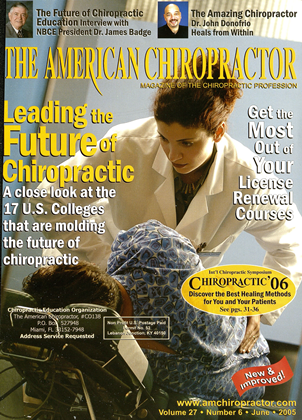F ROM ITS BIRTH TO THE PRESENT, THE CHIROPRACTIC PROFESSION has been interested in methods to restore normal alignment (structure) to the spinal column, with the ultimate purpose of restoring normal function to the spine and nervous components housed inside. Interestingly, mechanical traction has been used by chiropractors to reduce spinal misalignments, in spite of the fact that chiropractic is a profession founded on the principle of "by hands only" interventions. In this brief treatise, the use of mechanical traction as a means to reduce subluxations of the lumbar lordotic curve is traced from the profession's origin to the modern era. Lumbar Extension Traction The use of traction for subluxation correction can be traced to chiropractic's original "mixer" practitioner, Solon Massey Langworthy, D.C.,a 1901 graduateof D. D. Palmer's chiropractic school. Langworthy, one of Palmer's original twelve chiropractic disciples, established a thriving practice and chiropractic school (American School of Chiropractic and Nature Cure) in Cedar Rapids, Iowa, in the early 1900s. In a recent article published in the journal Chiropractic History, Troyanovich and Gibbons' recount the important contributions made by this colorful chiropractic pioneer. One of Langworthy's inventions was known as the "Amplia Thrill" traction table. He received a patent for the device in October of 19082 and it is depicted in Figure I. The device was quite versatile and had the capability of performing both cervical extension traction and lumbar extension traction. The Amplia Thrill. Price $350. More recently, Steve Foster, D.C, of Greeley, Colorado, has created a device to induce lumbar extension traction in an erect kneeling position, in a method he describes as 5-point traction. His invention was created circa 1995' and is depicted in Figure 2. Our own Roger Coleman, D.C. (yeah, it's a little self-serving— sorry) created a method whereby extension traction of the lumbar spine can be induced in a patient who is standing.4 The Coleman device and method further allow the patient to perform active extension exercises while in the device, which may add to the clinical effectiveness of the method. Coleman's invention is depicted in Figure 3. Lumbar extension traction has been used from the time of the earliest chiropractic pioneers until the present as a means of restoring normal alignment to the lordotic curve of the lumbar spine. Although founded on the principle that chiropractic is a "hands only" method of care, chiropractic innovators have devised multiple mechanical devices to assist in the reduction of the chiropractic lesion. I n our next column, we' 11 present a case that demonstrates how some of these devices may be used to reduce pain, restore spinal alignment, and restore spinal function. EH Note: This information in not intended as healthcare advice. The determination of the ri.sk and usability oj information rests entirely with the attending doctor of chiropractic. Dr. Roger R. Coleman is a 1974 graduate of Palmer College of Chiropractic, practicing in Othello, WA. He is a member of the Adjunct Research Faculty at Life Chiropractic College West, and on the postgraduate faculty of National University of Health Sciences Dr. Stephan ./. Trovanovich is a I9S7 graduate of Palmer College of Chiropractic, practicing in Normal, IL, and a member of the Adjunct Research Faculty. Dept. of Research, at Life Chiropractic College West. He may be reached at 309-454-5556. References Troyanovich SJ, Gibbons RW. Finding Langworthy: the last years of a chiropractic pioneer. Chiro Historv 2()03;23:9-l 7. United States Patent Office letter of acceptance to Solon Massey Langworthy for Patent #901.628. 20 October 190X. United States Patent Office letter of acceptance to Steven K. Foster for Patent #5.575.765. Coleman R. Lumbar traction: a non-science article. Am J Clin Chiro I999;9:7. Figure 1. Langworthy's "Amplia Thrill" traction table. Figure 2. Foster's "5 Point" traction system. Figure 3. Coleman's standing lumbar extension traction system.
 View Full Issue
View Full Issue






